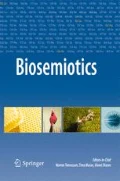




Similar content being viewed by others
Notes
Cf. Maturana (1978).
By subjective we mean lead by an experiencer subject: the cognitive entity.
Mature doesn’t necessarily mean the final stage of a global development, but the system’s readiness to react at any particular phase.
Cf Uexkull (1909)
In general (Nl×Nc) indicates de dimensions of a Matrix, Nl being the number of its rows and Nc that of its columns; thus, (N×1) represents an N-component vector in the form of a column matrix.
References
Cassirer, E. (1996). The philosophy of symbolic forms, vol. 4. The metaphysics of symbolic forms. New York: Yale University Press.
Ferreira, MIA (2010). On Meaning: a biosemiotic approach. Biosemiotics 3. Springer. 107–130
Ferreira, M. I. A. (2011). On Meaning: Individuation and Identity. England: Cambridge Scholars Publishers.
Maturana, H. R. (1978). Biology of language: The epistemology of reality. In G. Miller & E. Lenneberg (Eds.), Psychology and biology of language and thought. New York: Academic.
Uexkull, J. von (1909) Umwelt und Innenwelt der Tiere. Springer
von Uexküll, J. (1934). A stroll through the worlds of animals and Men- a picture book of invisible worlds. In C. H. Schiller (Ed.), Instinctive behaviour, the development of a modern concept. New York: International Universities Press.
Varela, F. J. (1992). Autopoiesis and a Biology of Intentionality. Proceedings from the Dublin Workshop on Autopoiesis and Perception, essay 1. (available @ www.eeng.deu.ie/pub/autonomy/bmem9401)
Author information
Authors and Affiliations
Corresponding author
Rights and permissions
About this article
Cite this article
Aldinhas Ferreira, M.I., Caldas, M.G. Modelling Artificial Cognition in Biosemiotic Terms. Biosemiotics 6, 245–252 (2013). https://doi.org/10.1007/s12304-012-9159-z
Received:
Accepted:
Published:
Issue Date:
DOI: https://doi.org/10.1007/s12304-012-9159-z




